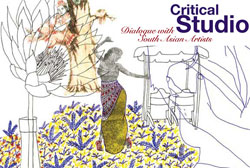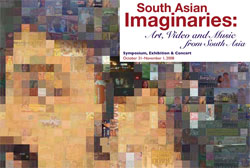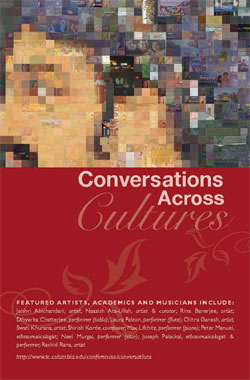"Conversations Across Cultures" Series Focuses on South Asian Art
Just how does one understand a painting by a Pakistani artist that is titled, “What is So Pakistani About this Painting”?
“I wanted to leave the burden of identity behind,” declared Rashid Rana to a group of Teachers College students gathered in Milbank Chapel. “But even if you deny that you don’t want to deal with this question in your work, it still remains about that.”
Rana’s preoccupation with identity was typical of the artists, musicians and educators who gathered at TC on Halloween weekend for South Asian Imaginaries, a two-day, for-credit symposium on contemporary art in Pakistan, India and other countries in the region that increasingly are commanding attention on the world’s artistic stage.
The symposium concluded TC’s annual Conversations Across Cultures series, which this year focused on South Asian art. The series began on October 13 with an exhibition in
During the concluding weekend, many of the participants spoke about having one foot in their country of heritage and the other in their country of residence. How, for instance, does one navigate the boundaries between Bombay and Brooklyn? In her Reconciliations series, conceptual artist Jaishiri Abichandani merged panoramic photographs of two, or more, different cities (the London Eye Ferris wheel set in the orange glow of Mumbai’s Marine Drive, for example) to form a mostly unified image that explores and subverts current geopolitical tensions but is realistic enough to look at home on a Wikipedia Web page. In a composite of
In Untitled, a triptych painting from her Tales of Amnesia series, Chitra Ganesh (another Brooklyn-based provocateur of Indian descent), echoed the graphic panel-and-text aesthetic of comic books to recreate violent stories of female trauma in traditional Hindu mythology, replete with severed body parts. And Mumbai-based artist Debanjan Roy’s farcical sculptures of Gandhi sitting with a laptop or chatting on a cell phone reflected the currents of social and historical change.
The region’s music parallels these concerns. Composer Shirish Korde, born in
And Peter Manuel, an ethnomusicologist at the City University of New York and author of Cassette Culture: Popular Music and Technology in North India, talked about how the North Indian music scene is being transformed by two broad socio-economical trends: the rapid ascent of the Indian bourgeoisie and the continually fraying relationship between Muslims and Hindus. The current explosion of Sufi-inspired rock, New Age pop, as well as more traditional genres of devotional Sufi music, Korde attributed to efforts by “the intelligentsia” to “promote communal harmony.” Some critics, he said, have been quick to cry shallow.
Critics’ judgments aside, “South Asian Imaginaries” made one thing clear: South Asian artists may be questioning who they are, but South Asian art is asserting its own identity.
Published Monday, Dec. 1, 2008


